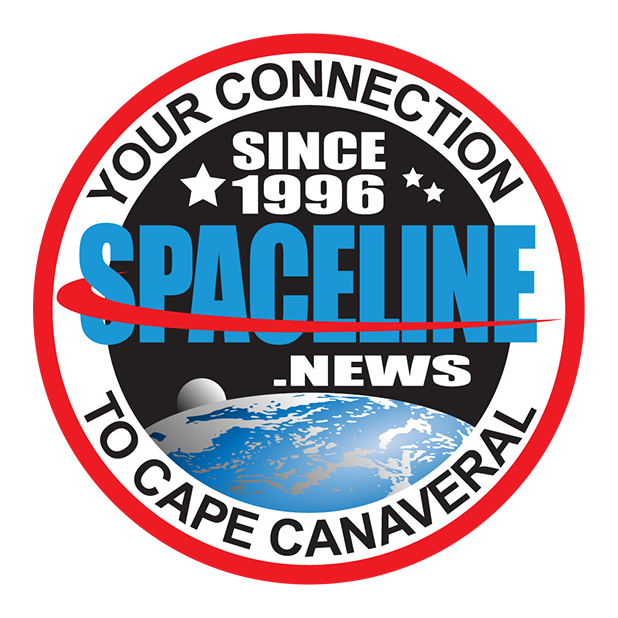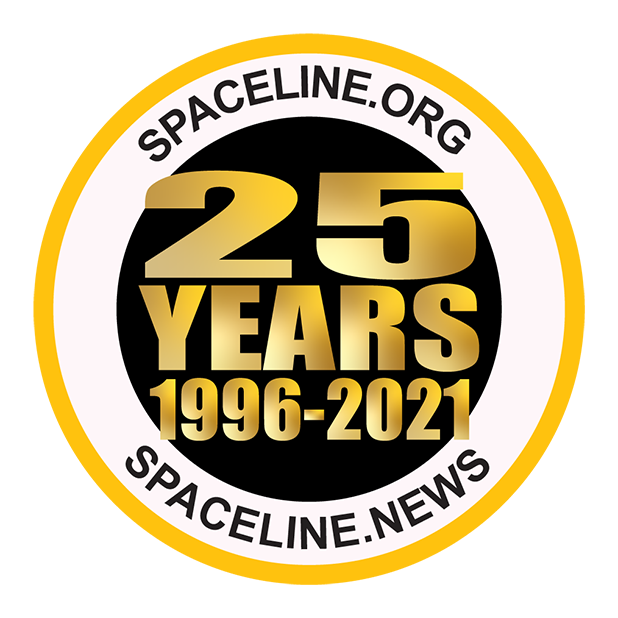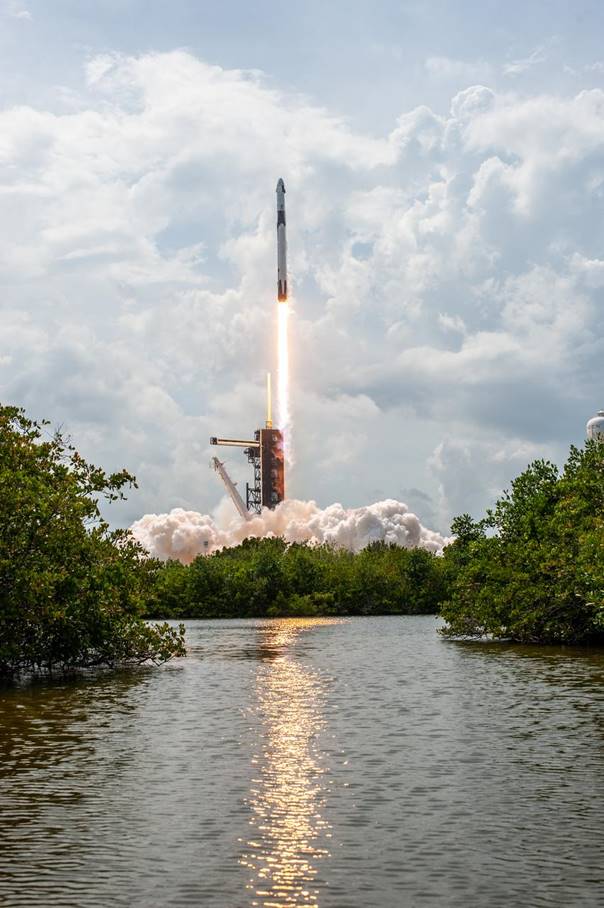
Falcon 9 Crew Dragon Demo-2 Launch, Photo Courtesy NASA
Falcon 9 Supports First U.S. Manned Launch Since 2011
May 30, 2020 | Reported by Cliff Lethbridge
It was one of those historic moments that will be etched in the memory of the U.S. space program for years to come. A SpaceX Falcon 9 rocket successfully launched a Crew Dragon spacecraft carrying astronauts Bob Behnken and Doug Hurley at 3:22 p.m. EDT today from Launch Pad 39A at the Kennedy Space Center. Launch was originally set for May 27 but was postponed due to bad weather. This was the first manned launch from U.S. soil since the Space Shuttle was retired in July, 2011 and the first time U.S. astronauts were launched aboard a commercial rocket and spacecraft. The mission, Crew Dragon Demo-2, will be the final Crew Dragon test flight prior to regularly scheduled astronaut crew flights to and from the International Space Station under the NASA Commercial Crew Program contract with SpaceX. It will provide critical data on the performance of the Falcon 9 rocket, Crew Dragon spacecraft, ground support systems as well as on-orbit operations, docking and landing operations.

Falcon 9 Crew Dragon Demo-2 Launch From Firing Room, Photo Courtesy NASA
The Crew Dragon spacecraft is 13 feet in diameter and 26.7 feet in height. It weighs 13,228 pounds at launch and 6,614 pounds upon return to Earth. It is capable of carrying up to seven people into space. Crew Dragon has a trunk at its base for support and the carriage of equipment and is jettisoned just prior to the return to Earth. The space suits worn by the astronauts are far more comfortable and less bulky than those employed in previous manned space flights. The suits were designed and manufactured by SpaceX. They are designed to provide pressurization and temperature control for the astronauts during flight. Features of the spacesuits include a 3D printed helmet, touchscreen compatible gloves, flame resistant outer layer and hearing protection.
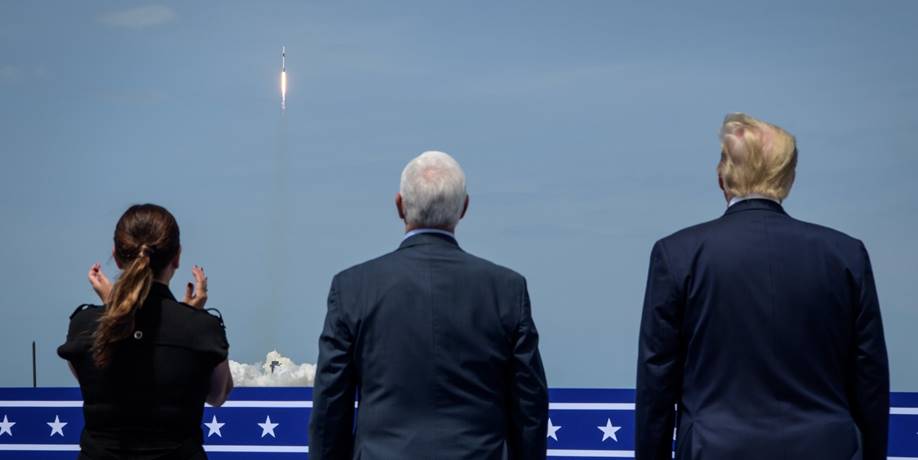
Second Lady Karen Pence (Left) Vice President Mike Pence (Center) And President Donald Trump (Right) View Falcon 9 Crew Dragon Demo-2 Launch, Photo Courtesy NASA
SpaceX controlled today's launch from the historic Kennedy Space Center Launch Control Center Firing Room 4, which the company is now leasing as its primary launch control center. The Launch Control Center has previously supported the historic Apollo, Skylab, ASTP and Space Shuttle programs and is located adjacent to the cavernous Vehicle Assembly Building. Once launched, Crew Dragon is controlled by the SpaceX Mission Control Center in Hawthorne, California in association with International Space Station (ISS) Mission Control Center at the Johnson Space Center in Houston, Texas. Crew Dragon is scheduled to autonomously dock with ISS at 10:29 a.m. EDT Sunday, May 31. This will be the first manned spacecraft to autonomously dock with ISS, but the astronauts aboard will be able to take over the docking procedures should a problem develop. Crew Dragon will be berthed at the forward port of the ISS Harmony Module. It has not yet been determined how long astronauts Behnken and Hurley will remain aboard ISS, they could be there as long as several months if conditions warrant prior to returning to Earth aboard Crew Dragon with a splashdown on the Atlantic Ocean.

Astronauts Bob Behnken (Left) And Doug Hurley (Right) Photo Courtesy NASA
Astronaut Behnken is the joint operations commander for the Crew Dragon Demo-2 mission. As such he will oversee activities such as rendezvous, docking and undocking as well as continuing mission activities regarding Crew Dragon Demo-2 while aboard ISS. Behnken was selected as an astronaut in 2000 and flew aboard STS-123 and STS-130, performing three spacewalks during each mission. Astronaut Hurley is the spacecraft commander for the Crew Dragon Demo-2 mission and is in charge of activities including launch, landing and recovery. He was selected as an astronaut in 2000 and flew aboard STS-127 and STS-135, the final Space Shuttle mission. President Donald Trump and Vice President Mike Pence were both on hand at the Kennedy Space Center for today's launch, viewing it from the balcony of the OSB-II building across the street from the historic Vehicle Assembly Building (VAB). The two participated in a ceremony and reception inside the VAB following the launch. Both made comments to hundreds of invited guests, dignitaries and media praising SpaceX and NASA for a job well done and looking forward to returning humans to the Moon by 2024 and Mars beyond that. Both efforts will require cooperation between the U.S. government and commercial companies like SpaceX in order to be successful. Should all go well during this mission, the first operational Crew Dragon manned flight is tentatively set for August 30, 2020.

President Donald Trump Welcomed By Guests, Photo Courtesy Cliff Lethbridge/Spaceline

Falcon 9 Crew Dragon Demo-2 On Launch Pad, Photo Courtesy Carleton Bailie/Spaceline
Falcon 9 Crew Dragon Demo-2 Launch Scrubbed
May 27, 2020 | Reported by Cliff Lethbridge
Today's SpaceX Falcon 9 Crew Dragon Demo-2 launch from Launch Pad 39A at the Kennedy Space Center has been scrubbed. Bad weather throughout the day had improved with only one weather constraint remaining red at launch time, that of unacceptable field mil readings, an indication of electrical activity on the ground and in the atmosphere. Those measurements were trending favorably in the minutes prior to launch, but more time was needed to evaluate them than was possible with only an instantaneous launch window available at 4:33 p.m. EDT. Launch was officially scrubbed at T-minus 16 minutes, 54 seconds. The next launch opportunity will be on Saturday, May 30 at 3:22 p.m. EDT. The SpaceX Crew Dragon spacecraft will be carrying astronauts Doug Hurley and Bob Behnken to the International Space Station in the last test flight before regularly scheduled manned flights can begin. This will be the first manned launch from U.S. soil since the retirement of the Space Shuttle program in July, 2011.
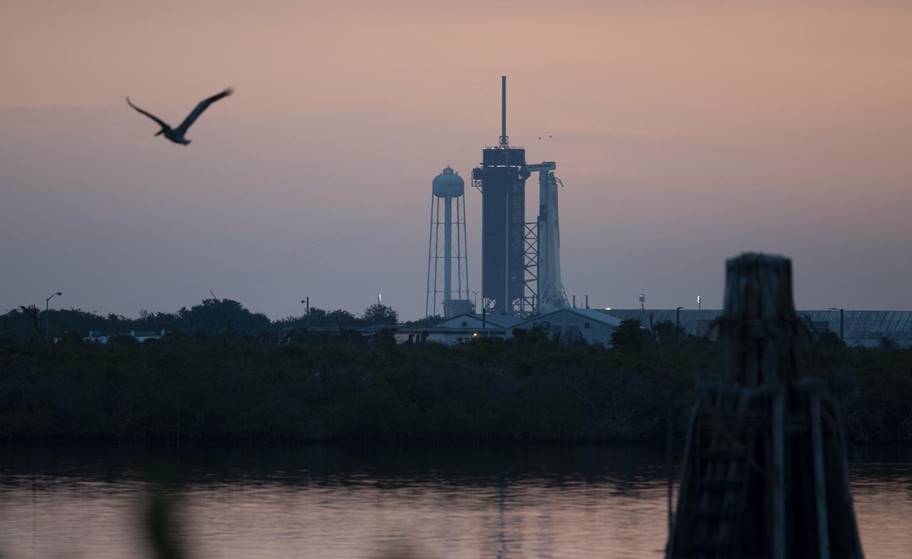
Falcon 9 Crew Dragon Demo-2 On Launch Pad, Photo Courtesy NASA

Atlas V USSF-7/OTV-6 Launch, Photo Courtesy Liz Allen/Spaceline
Atlas V Successfully Launches USSF-7/OTV-6 For U.S. Space Force
May 17, 2020 | Reported by Cliff Lethbridge
A United Launch Alliance Atlas V rocket successfully launched the USSF-7/OTV-6 payload from Launch Pad 41 on Cape Canaveral Air Force Station at 9:14 a.m. EDT today. Launch was delayed one day due to bad weather. The rocket launched today was in the Atlas V 501 configuration, featuring a five-meter payload fairing, no solid rocket boosters and a single-engine Centaur second stage. Today's launch was dedicated to front-line responders and those affected by the Covid-19 pandemic. United Launch Alliance Vice President of Government and Commercial Programs Gary Wentz explained, "We are honored to partner with the U.S. Space Force and Air Force to recognize healthcare workers, first responders and other essential personnel affected by the Covid-19 pandemic".

Atlas V USSF-7/OTV-6 Launch, Photo Courtesy Liz Allen/Spaceline
USSF-7 (United States Space Force-7)/OTV-6 is comprised of an X-37B spaceplane, for a series of test flights designated as an Orbiter Test Vehicle (OTV). This is the first X-37B OTV to employ a service module to host experiments. The service module is attached to the aft end of the spacecraft. In addition to on-board experiments, both classified and unclassified, a small satellite named FalconSat-8 will be deployed. The satellite was developed by the U.S. Air Force Academy and sponsored by the Air Force Research Laboratory and will conduct a series of experiments while in orbit. This OTV mission also contains two NASA experiments, one to test the effects of space on various materials and the other to evaluate the effect of space on seeds which may be used to grow food for long duration space flights. Yet another experiment, sponsored by the Naval Research Laboratory, will test a method of using solar energy to create radio frequencies that can be transmitted to the ground.

Atlas V USSF-7/OTV-6 In Flight, Photo Courtesy Liz Allen/Spaceline
The X-37B OTV itself began its life as the NASA X-37 program in 1999, but subsequently transferred to the U.S. Department of Defense in 2004. The X-37B looks very much like a scaled down version of the Space Shuttle, wholly appropriate as the spaceplane has its roots in the Space Shuttle program and shares many of its unique flight characteristics. The vehicle, about one-fourth the size of a Space Shuttle, currently uses two former Space Shuttle Orbiter Processing Facilities at the Kennedy Space Center for launch preparations and lands at the former Space Shuttle Landing Facility. Most of the elements and purposes of the X-37B OTV remain secret, but the Air Force says it is "an experimental test program to demonstrate technologies for a reliable, reusable, uncrewed space test platform for the U.S. Air Force". The X-37B OTV has a length of 29 feet, 3 inches, a wingspan of 14 feet, 11 inches, a height of 9 feet, 6 inches and has a payload bay measuring 7 feet by 4 feet. The spaceplane weighs about 11,000 pounds at launch.
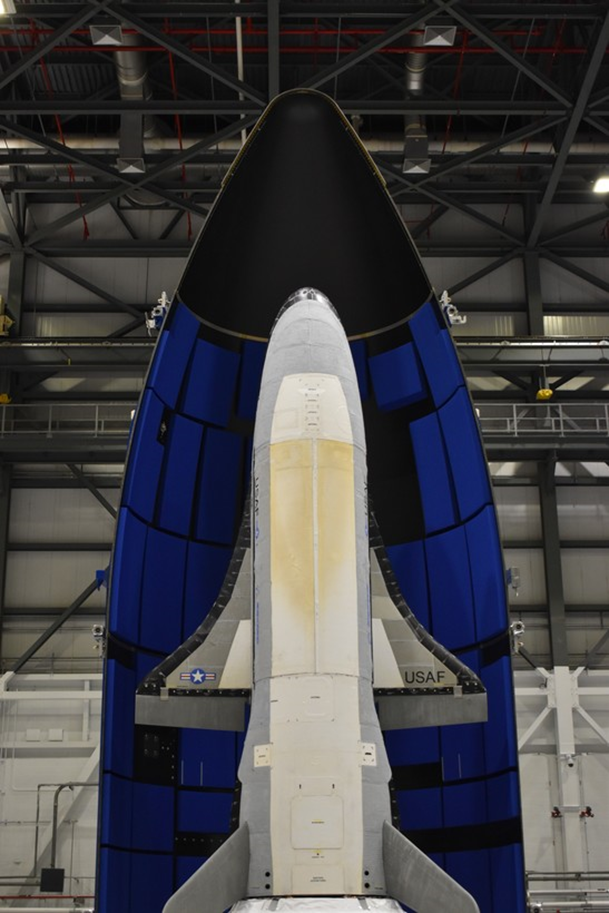
X-37B/OTV-6 Inside Atlas V Payload Fairing, Photo Courtesy Boeing
This is the sixth flight of the X-37B OTV in a series utilizing two operational vehicles. OTV-1 was launched on April 22, 2010 and landed on December 3, 2010 for a mission duration of 224 days. OTV-2 was launched on March 5, 2011 and landed on June 16, 2012 for a mission duration of 469 days. OTV-3 was launched on December 11, 2012 and landed on October 17, 2014 for a mission duration of 675 days. OTV-4 was launched on May 20, 2015 and landed on May 7, 2017 for a mission duration of 718 days. OTV-5, the longest OTV mission to date, was launched on September 7, 2017 and landed on October 27, 2019 for a mission duration of 780 days. The planned mission duration of the current flight, OTV-6, remains a secret. All of the OTV launches have been aboard Atlas V rockets with the exception of OTV-5, which was launched aboard a Falcon 9 rocket. The X-37B OTV's are built by prime contractor Boeing. Boeing had proposed building the X-37C, about twice the size of the X-37B, and capable of carrying up to six astronauts into space. However the company is committed to the development of their CST-100 Starliner spacecraft, already being tested to carry astronauts to and from the International Space Station. It should also be noted that there was an X-37A, a NASA Approach and Landing Test Vehicle, which was used in drop and glide tests in 2005 and 2006, but never flown in space.

Dedication Painted On Atlas V, Photo Courtesy U.S. Space Force

Thick Clouds And Rain At Launch Pad 41, Photo Courtesy Carleton Bailie/Spaceline
Atlas V Launch Scrubbed Due To Bad Weather
May xx, 2020 | Reported by Cliff Lethbridge
Today's launch of a United Launch Alliance Atlas V rocket from Launch Pad 41 on Cape Canaveral Air Force Station was scrubbed due to bad weather. Thick cumulus clouds and high winds at the Cape plagued the launch all morning and did not improve during the two launch windows available for this flight. There was a 10-minute launch window from 8:24 a.m. to 8:34 a.m. EDT and a second 10-minute launch window from 10:13 a.m. to 10:23 a.m. EDT. Although the countdown progressed to T-minus 60 seconds at the end of the second launch window, violations of the cumulus cloud rule and high winds rule could not be waived and the launch was officially scrubbed at that time. Launch has been rescheduled for 9:14 a.m. EDT on May 17, 2020 and weather is forecast to be vastly improved, with an official 70% chance of acceptable conditions. The rocket will carry an X-37B "Orbital Test Vehicle" (OTV) on the sixth OTV mission, designated OTV-6, as well as experiments in the USSF-7 (United States Space Force-7) payloads into space. The launch is dedicated to those at the front lines as well as the victims of the Covid-19 pandemic.

News Media Convoy Awaits Scrub Announcement, Photo Courtesy Cliff Lethbridge/Spaceline





